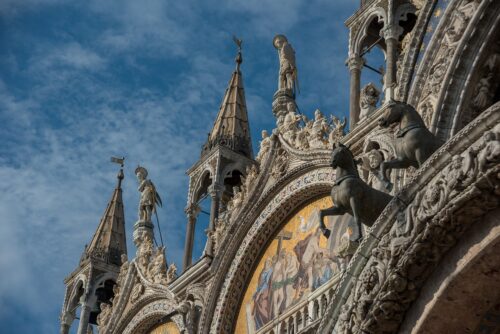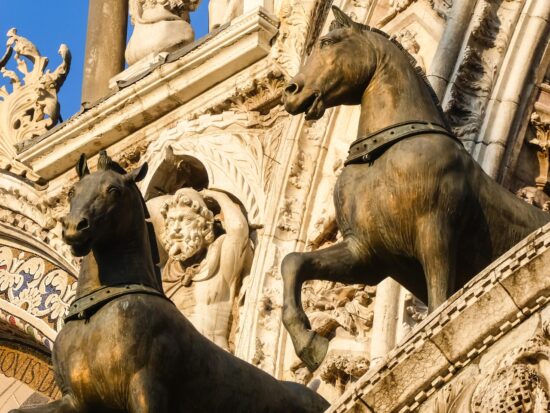St. Mark’s Basilica
St. Mark’s Basilica or the Basilica di San Marco in Italian is a shining example of what can be described as the Champion’s League league of European Cathedrals. Their story and presence, are so intertwined with the history of the city, that learning about its particular story is like learning the main events that formed the city itself.
The story began at a time when Venice had just managed to defend itself against the attack of Charlemagne‘s son Frankish army, a success that had helped her establish trading rights in the Adriatic and relative freedom to do business within the waters of the Eastern Roman Empire (Byzantine).
In one of many trips to the east, two Venetian merchants visited Alexandria, then part of the Muslim Abbasid Caliphate and after finishing their business, went to worship the relics of Saint Mark, the saint who had evangelized the people of the Veneto, in the church dedicated to him.


There, they learned from a monk and the priest of the sanctuary that the church risked being destroyed by the Arab governor of Alexandria who had decided to use marble and columns from the Christian churches to build a palace in the ancient city of Babylon.
The merchants offered to take them back to Venice and in a move that would contribute to the early stereotype perception of the canning Venetian merchantman, a type of new Ulysses, they managed to coax the two sacristans and load the relics aboard ship, concealed in wicker baskets and protected by cabbage leaves and pork.
Muslim religion deemed pork meat to be “unclean” and disgusting so the Venetian ship slipped through customs with an inspection taken out of every smuggler’s dream. On 31st January 828, the body of St. Mark reached Venice.
The relics were initially placed in a corner of the Ducal Palace to await the building of the new basilica that was to house them. The shrine to the new “Italian patron” St. Mark after the Greek St.Theodore, signaled Venice’s emancipation from Byzantium, inaugurated a new era of relations with the Roman Church, and gave the city a new potent symbol that could attract pilgrims and give Venetians a sense of divine protection.


The first church was completed by 832 and became the basis of the present-day crypt. In 976 the second structure would commence on the remains of the first church that had been destroyed by a fire earlier that year. The third and final construction came at a time when the city had regained the control of Dalmatia from the Kingdom of Croatia and many building projects were in progress.
It would last from 1063 until the early 1090’s when it was consecrated by Doge Vitale Faliero, the first Doge to have its image portrayed next to the high altar of St. Mark’s Basilica.
By 1106 the main features of the structure, its Romanesque mixture of Italian and Byzantine styles, its five lowered cupolas, its marble columns, and its arches were all in place creating a prototype amalgam of eastern and western architecture that would be known as purely Venetian.


After the conquest of Constantinople in 1204 Venice became the capital of the new ruling Empire of the East. Shipment after shipment, new trophies of precious materials, marble complexes, columns, sculptures, mosaics, and friezes from the east reached the new Mecca and became incorporated into the city’s most important temple. 13th-century additions would make San Marco a true Chiesa d’Oro, “Church of Gold” a nickname already in use since the construction of the Byzantine high altarpiece made of gold, silver, and thousands of precious gems in the 10th century.
The greatest part of the 8000 square meters of gilded mosaics in the interior was complete by the 1270s when in the second half of the 14th century the construction of the Baptistery and Chapel of St. Isidore, the iconostasis and sculptures decorating it as well as the Gothic decoration of its exterior facade with spires, niches, and sculptures of angels and saints had added even more elements to the whole collage.
Most of the official ceremonies of the state, like the Doge’s first oaths to his Venetian subjects, official processions, the blessing of the army’s heads, and the crusaders on their way to the holy land were held in the official church of the Doges.
San Marco was also the place of prayer & comfort for Venetian people in the darkest of times such as plague epidemics as an exception as it was exclusively used for state and dogal affairs. This was the case until the abolition of the Republic by Napoleon in 1797, when it became the east of the Patriarch of Venice and the city’s cathedral (1807).


The Basilica is open for tourist visits from Monday to Saturday from 9:30 a.m. to 5 p.m. and on Sunday from 2 to 4 p.m. On Sunday mornings, you can attend mass, but not wander around.
The entrance to the church is free which makes the waiting lines unbearable except if you reserve your entrance ticket in advance online and save yourself the trouble for a small price. (Here)
Keep in mind that entrance to San Marco Museum, the Treasury, and the Golden Altarpiece and of course, the Campanile requires a separate ticket so one of the guided tours that include access to all of San Marco’s interest points would be advisable. More about San Marco



